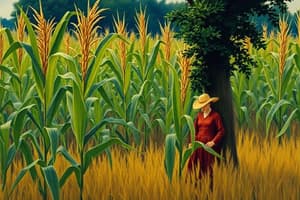Podcast
Questions and Answers
What role did maize play in the lives of indigenous peoples of the American Southwest?
What role did maize play in the lives of indigenous peoples of the American Southwest?
Maize served as a vital source of food and sustenance for indigenous peoples in the American Southwest.
How did the Columbian Exchange impact both the Old and New Worlds?
How did the Columbian Exchange impact both the Old and New Worlds?
The Columbian Exchange facilitated the transfer of plants, animals, ideas, and technologies, profoundly altering societies and economies in both hemispheres.
Describe the encomienda system and its effects on indigenous peoples.
Describe the encomienda system and its effects on indigenous peoples.
The encomienda system granted Spanish settlers the right to extract forced labor from indigenous people, often leading to their exploitation and mistreatment.
Who was Bartolomé de las Casas and what was his significance?
Who was Bartolomé de las Casas and what was his significance?
What was the primary focus of mercantilism in the 16th to 18th centuries?
What was the primary focus of mercantilism in the 16th to 18th centuries?
What was the primary purpose of the Treaty of Tordesillas?
What was the primary purpose of the Treaty of Tordesillas?
What was the outcome of the Pueblo Revolt of 1680?
What was the outcome of the Pueblo Revolt of 1680?
Who was Richard Hakluyt and what did he advocate for?
Who was Richard Hakluyt and what did he advocate for?
How did the Pilgrims' motivations for settling differ from those of the Puritans?
How did the Pilgrims' motivations for settling differ from those of the Puritans?
Explain the term 'mestizo' and its significance in colonial society.
Explain the term 'mestizo' and its significance in colonial society.
Describe the nature of French colonization in terms of their relationships with Native Americans.
Describe the nature of French colonization in terms of their relationships with Native Americans.
How did Spanish attitudes toward Native Americans vary during colonization?
How did Spanish attitudes toward Native Americans vary during colonization?
What was the fate of the Roanoke colony and why is it notable?
What was the fate of the Roanoke colony and why is it notable?
How did English settlers' relationships with Native Americans vary?
How did English settlers' relationships with Native Americans vary?
What was the role of the fur trade in French colonization?
What was the role of the fur trade in French colonization?
What was the significance of the Dutch-Indian Wars in the context of Dutch colonization?
What was the significance of the Dutch-Indian Wars in the context of Dutch colonization?
Flashcards are hidden until you start studying
Study Notes
Maize and Its Importance
- Maize, or corn, is a staple crop originating from Mesoamerica (Mexico and Central America).
- It became essential food for indigenous peoples in the American Southwest after its introduction.
Columbian Exchange
- The Columbian Exchange facilitated the transfer of plants, animals, cultures, ideas, and technologies between the Old World (Europe, Africa, Asia) and the New World (Americas).
- Initiated by Columbus’s voyages in the late 15th century, it significantly transformed both hemispheres.
Spanish Colonization and Native Relations
- Spanish colonization features a complex dynamic with indigenous peoples; relationships varied from harsh exploitation to attempts at conversion to Christianity.
- The encomienda system was established, allowing Spanish settlers to enforce forced labor from Native Americans under the guise of protection and religious conversion.
Encomienda System
- The encomienda system permitted Spanish settlers (encomenderos) to extract labor from indigenous populations, often leading to exploitation and mistreatment.
Mestizo Identity
- Mestizo refers to individuals of mixed European and indigenous American descent, embodying cultural blending during the Spanish colonization.
Bartolomé de las Casas
- A Spanish Dominican friar, Bartolomé de las Casas advocated for indigenous rights and documented their mistreatment by Spanish settlers.
Treaty of Tordesillas
- Signed in 1494, this treaty divided new lands outside of Europe between Portugal and Spain, establishing a line in the Atlantic Ocean for territorial rights.
Pueblo Revolt
- The Pueblo Revolt of 1680 was a notable uprising by Pueblo Native Americans against Spanish colonization, resulting in the temporary expulsion of Spaniards from New Mexico.
Atlantic World Dynamics
- The Atlantic World encompasses the interwoven commercial, religious, philosophical, and political relationships among Europeans, Africans, and Native Americans during the Age of Exploration, reshaping societies.
Mercantilism
- Mercantilism was an economic doctrine in the 16th to 18th centuries prioritizing wealth accumulation, export promotion, and control over colonial trade for national power.
Richard Hakluyt's Contributions
- Richard Hakluyt was an English geographer advocating for North American exploration and colonization, promoting England's colonial ambitions through his writings.
Puritans' Goals
- Puritans were English Protestants aiming to reform the Church of England from Catholic influence, with many settling in the Massachusetts Bay Colony for religious freedom.
Pilgrims/Separatists
- The Pilgrims were Separatists who traveled on the Mayflower in 1620, establishing Plymouth Colony in Massachusetts, also in search of religious liberty.
French Colonization Practices
- French colonization often involved cooperative relationships with Native American tribes, particularly in the fur trade, fostering trade alliances.
Dutch Colonization Approach
- Dutch colonization in New Netherland (modern-day NY/NJ) featured mixed relations with Native Americans, involving trade and conflicts, notably the Dutch-Indian Wars.
English Colonization Relationships
- English settlers experienced varied interactions with Native Americans, with some regions marked by conflict (e.g., Jamestown) and others by cooperation (e.g., Pilgrims and Puritans).
Roanoke's Mystery
- Roanoke, an early English settlement in North Carolina, mysteriously vanished between 1587 and 1590, leading to its designation as "The Lost Colony," with its inhabitants' fate still unknown.
Studying That Suits You
Use AI to generate personalized quizzes and flashcards to suit your learning preferences.




